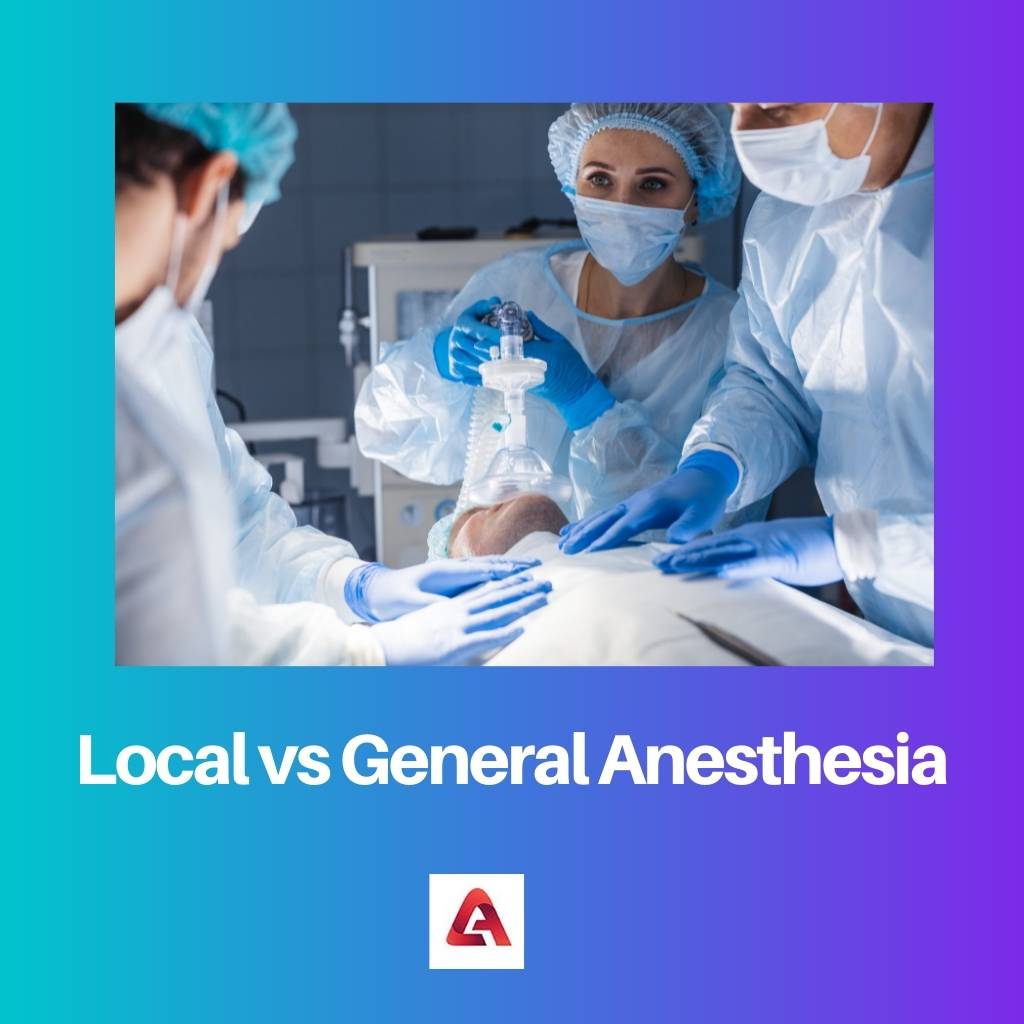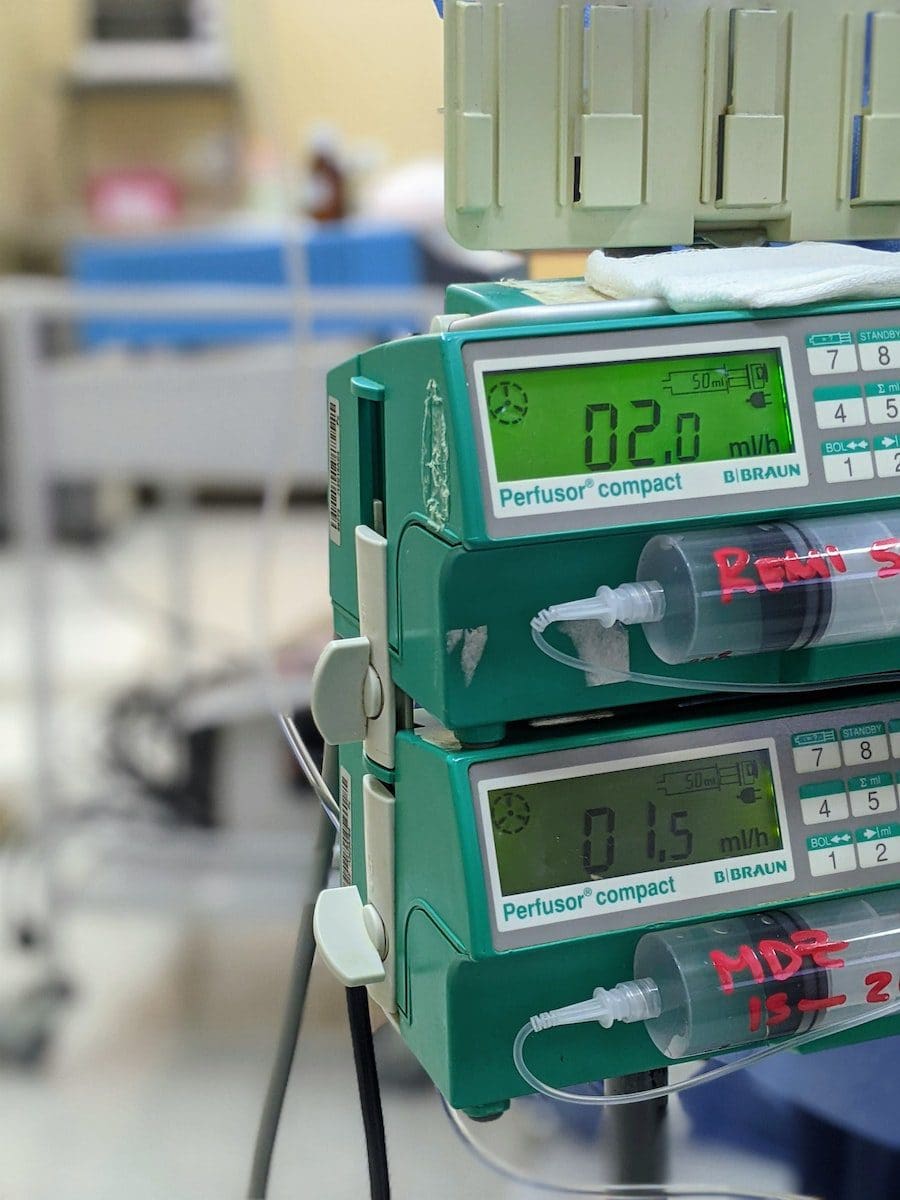Anaesthesia can be of many different types.
One is the injection of local anaesthesia that is used to numb just one particular area like a finger or tooth; another is general anaesthesia which, when given, causes the loss of consciousness for a limited period of time.
These anaesthesia are provided by specialist doctors who are anaesthetics that are also supported by a team of nurses and resident surgeons apart from the local anaesthesia as it can be provided by anyone.
In simpler and more convenient words, anaesthesia could be defined as a loss of sensations.
Key Takeaways
- Local anesthesia numbs a specific area, allowing patients to stay awake during minor procedures.
- General anesthesia induces unconsciousness for major surgeries, ensuring patients feel no pain.
- Recovery time for local anesthesia is shorter, with fewer side effects than general anesthesia.
Local vs General Anesthesia
Local anaesthesia is a type of anaesthesia that numbs a small part of the body without affecting consciousness. It is administered through an injection or topical application of an anaesthetic medication. General anaesthesia is a type of anaesthesia that affects the entire body and causes the patient to lose consciousness. It is administered through an intravenous injection or inhalation of an anaesthetic gas.

Local anaesthesia numbs just a small particular area or part of the body so that it can be operated on. Generally, it is used when the nerves of that part are easy to reach via some drops, ointments, sprays, or even injections.
During this procedure, after the injection of local anaesthesia, you stay conscious, but that area is free from pain as that has been numbed.
General anaesthesia is used when there is something serious to be operated on or a big surgery.
After the general anaesthesia, the patient undergoes total unconsciousness, during which they feel nothing and wakes up after a period of time. In fact, when you are anaesthetized, you will have literally zero memory of that time.
Comparison Table
| Parameters of Comparison | Local Anesthesia | General Anesthesia |
|---|---|---|
| What are they | Local anesthesia numbs just a small particular area or part of the body so that it can be operated on. | General anesthesia is used when there is something serious to be operated on or a big surgery. |
| Numbness | Local anesthesia numbs a particular part of the body that has to be operated on. | General anesthesia numbs the whole body making the patient unconscious. |
| Examples | Tooth removal, surgery for an ingrowing toenail that occurs with people, and some minor eye surgeries. | Operating in the heart, lungs, and abdomen, and the most important ones in the brain. |
| Ways of injection | It can be injected via ointments, sprays, or injections. | General anesthesia is injected in two ways. One is injecting the anesthetic medicine through the veins, and the other is anesthetic gas that can be smelled by the person. |
| Effects | It numbs a particular portion of the body for some time. | The patient loses consciousness for some period of time. |
What is Local Anesthesia?
Local anaesthesia numbs just a small particular area or part of the body so that it can be operated on. Generally, it is used when the nerves of that part are easy to reach via some drops, ointments, sprays, or even injections.
During this procedure, after the injection of local anaesthesia, you stay conscious, but that area is free from pain as that has been numbed.
Some common examples of surgeries where local anaesthesia is used are tooth removal, surgery for an ingrowing toenail that occurs in people, and some minor eye surgeries.
Here, total unconsciousness of the patient is not required, and the surgery can be done by just numbing that particular portion of the body.
Local anaesthesia numbs that portion so that the patient does not feel any pain during the whole process.

What is General Anesthesia?
General anaesthesia is used when there is something serious to be operated on or a big surgery.
After the general anaesthesia, the patient undergoes total unconsciousness, during which they feel nothing and wakes up after a period of time. In fact, when you are anaesthetized, you will have literally zero memory of that time.
General anaesthesia is used in a wide range of surgeries while operating in the heart, lungs, and abdomen, and the most important ones in the brain. There are two different ways of giving general anaesthesia to someone.
One is injecting the anaesthetic medicine through the veins, and the other is anaesthetic gas that can be smelled by the person.
The anaesthetic medicine temporarily stops the brain from responding to any outside message travelling from the veins of the body.

Main Differences Between Local and General Anesthesia
- The main difference between local and general anaesthesia is that local anaesthesia numbs just a small particular area or part of the body so that it can be operated on, while General anaesthesia is used when there is something serious to be operated on or a big surgery.
- Local anaesthesia numbs a particular part of the body that has to be operated on, but General anaesthesia numbs the whole body making the patient unconscious.
- Examples of surgeries where local anaesthesia is used are tooth removal, surgery for an ingrowing toenail that occurs in people, and some minor eye surgeries. Examples, where general anaesthesia is used, are operating in the heart, lungs, abdomen and, most important, in the brain.
- Local anaesthesia can be injected via ointments, sprays, or injections, while General anaesthesia is injected in two ways. One is injecting the anaesthetic medicine through the veins, and the other is anesthetic gas that can be smelled by the person.
- Local anaesthesia numbs a particular portion of the body for some time, while in general anaesthesia, the patient loses consciousness for some period of time.

- https://www.nejm.org/doi/pdf/10.1056/NEJM197205042861805
- https://ehp.niehs.nih.gov/doi/abs/10.1289/ehp.9087199

The article provides a comprehensive understanding of local and general anesthesia, along with a detailed comparison of their applications. The explanations make it easy to comprehend the differences between the two.
I found the detailed breakdown of what local anesthesia and general anesthesia entail to be very useful in understanding their respective roles in medical procedures.
The article’s description of what each type of anesthesia does and how it is administered is very illuminating. It provides a clear insight into the applications of local and general anesthesia.
The simple and detailed explanations provided about local and general anesthesia are enlightening. The article serves as a useful guide for understanding these medical procedures.
I agree. The information about the ways of injection for local and general anesthesia is helpful for understanding their application in medical practice.
The comparison table effectively summarizes the key differences between local and general anesthesia, making it easier to understand the contrasting nature of these forms of anesthesia.
The detailed explanations provided in the article are very informative, offering a comprehensive understanding of local and general anesthesia and their applications. It is a useful guide for understanding these medical procedures.
The article effectively distinguishes between local and general anesthesia, highlighting the numbness of specific body parts for local anesthesia and the loss of consciousness with general anesthesia. The comparison table is very useful for understanding the contrasts.
I particularly appreciate the detailed explanation of the effects and applications of general anesthesia. The article has provided a comprehensive understanding of both forms of anesthesia.
I found the explanations of the examples of medical procedures requiring local and general anesthesia very informative, especially the distinct surgeries for each type.
The article gives a clear and concise explanation of local and general anesthesia, emphasizing the numbing effects of local anesthesia and the unconsciousness induced by general anesthesia. It is insightful and informative.
The detailed explanation of local anesthesia’s applications for minor surgeries and general anesthesia’s application for major surgeries is very helpful in understanding their respective uses.
The comparison table effectively outlines the differences between local and general anesthesia, providing a comprehensive understanding of the effects and administration methods of both types.
The article offers a detailed understanding of local and general anesthesia, providing clear explanations of their respective applications and effects. It serves as a useful guide for comprehending these medical procedures.
The comparison table effectively summarizes the differences between local and general anesthesia, making for a very informative and detailed explanation of both forms of anesthesia.
The detailed explanations of local and general anesthesia provided in this article are very useful. The benefits of local anesthesia for minor surgeries are well-defined, and the applications of general anesthesia are highlighted effectively.
I found the explanations about the specific examples of surgeries for local and general anesthesia very informative. It provides a clear understanding of when each type is applied.
This article also gives an insightful understanding of the impact of both types of anesthesia on patients, particularly how local anesthesia results in lesser effects compared to general anesthesia.
The article effectively explains the distinctions between local and general anesthesia, emphasizing the specificity of local anesthesia and the broader impact of general anesthesia. The information is well-presented and detailed.
The explanation of the ways of injecting local and general anesthesia is particularly helpful. It offers an insightful understanding of their administration methods in medical practice.
This article provides a clear explanation of the differences between local and general anesthesia and their applications in medical procedures. The recovery time and side effects of both types are also well explained.
I agree, most importantly, this piece has effectively summarized the key takeaways and the comparison between local and general anesthesia.
I appreciate the detailed information about the ways of giving general anesthesia. It is enlightening to know that it can be administered through veins and as an anesthetic gas.
The article provides a detailed comparison of local and general anesthesia, offering comprehensive information about their applications and effects. It is an informative guide to understanding these medical procedures.
I found the description of local anesthesia’s numbing effects and general anesthesia’s impact on consciousness very helpful in understanding their respective applications in medical procedures.